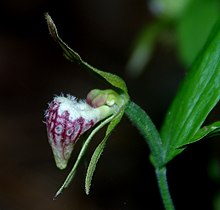Cypripedium arietinum
| Cypripedium arietinum | |
|---|---|

| |
| Scientific classification | |
| Kingdom: | |
| (unranked): | |
| (unranked): | |
| Order: | |
| Family: | |
| Subfamily: | |
| Genus: | |
| Species: | C. arietinum
|
| Binomial name | |
| Cypripedium arietinum R.Br. (1813)
| |
| Synonyms | |
| |
Cypripedium arietinum, the ram's head lady's slipper,[1] is a rare orchid that grows in lightly shaded areas with calcareous soils. It is characteristic of the alvars around the Great Lakes in North America, as well as in New England.[1][2] In Canada, it is found from Quebec to Saskatchewan, plus an isolated population in Nova Scotia, where it grows on gypsum based soils, 330 km away from the nearest population in Maine.[3][4]
Description
Cypripedium arietinum is a small lady's slipper which typically has 3, but sometimes 4-5, leaves. This species has a single flower on each stem having divided lateral sepals and a unique hairy pouch shaped like an funnel. The purplish-red flower has light venation and is white at the lip.

The plant grows to 10–40 cm (4–15.5 in), and the flowers may reach 1–2 cm (0.5–1 in). It flowers from May to June, producing brownish-green flowers with a pink and white lip.
The ram's head lady's slipper is difficult to cultivate, and rarely survives transplantation to a garden from the wild. It should never be removed from any natural area.
Conservation
Cypripedium arietinum is considered rare to extremely rare in all locations where it occurs.[5] More specifically, it is rare in Ontario[6] and rare in Manitoba. The ram's head lady's slipper is a threatened plant species other areas within its range, including Wisconsin, Minnesota, Michigan, and Saskatchewan. It is believed to be extirpated in Connecticut. This species has now been listed as an endangered species in Nova Scotia.[7]
References
- ^ a b NRCS. "Cypripedium arietinum". PLANTS Database. United States Department of Agriculture (USDA). Retrieved 1 July 2016.
- ^ Catling, P.M. and Brownell, V.R. 1999. Alvars of the Great Lakes Region. p. 375-391, in R. C. Anderson, J. S. Fralish, and J. M. Baskin (eds.) Savannas, Barrens and Rock Outcrop Communities of North America. Cambridge: Cambridge University Press.
- ^ Blaney, S. and D. Mazerolle. 2007. Nova Scotia Provincial Status Report on Ram's-Head Lady Slipper (Cypripredium arietinum R. Br.). Nova Scotia Department of Natural Resources.
- ^ Biota of North America Program, county distribution map
- ^ Blaney, S. and D. Mazerolle. 2007. Nova Scotia Provincial Status Report on Ram's-Head Lady Slipper (Cypripredium arietinum R. Br.). Nova Scotia Department of Natural Resources.
- ^ Oldham, M.J., and S.R. Brinker. 2009. Rare Vascular Plants of Ontario, Fourth Edition. Natural Heritage Information Centre, Ontario Ministry of Natural Resources. Peterborough, Ontario. 188 pp.
- ^ http://www.gov.ns.ca/natr/wildlife/biodiversity/species-list.asp
External links
 Media related to Cypripedium arietinum at Wikimedia Commons
Media related to Cypripedium arietinum at Wikimedia Commons Data related to Cypripedium arietinum at Wikispecies
Data related to Cypripedium arietinum at Wikispecies
